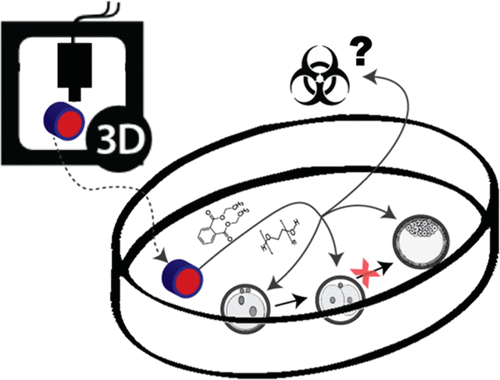当前位置:
X-MOL 学术
›
Environ. Sci. Technol. Lett.
›
论文详情
Our official English website, www.x-mol.net, welcomes your
feedback! (Note: you will need to create a separate account there.)
Potential Health and Environmental Risks of Three-Dimensional Engineered Polymers.
Environmental Science & Technology Letters ( IF 8.9 ) Pub Date : 2018-01-05 , DOI: 10.1021/acs.estlett.7b00495 Marcia de Almeida Monteiro Melo Ferraz 1 , Heiko H W Henning 2 , Pedro Ferreira da Costa 3, 4 , Jos Malda 2, 3, 4 , Séverine Le Gac 5 , Fabrice Bray 6 , Majorie B M van Duursen 7 , Jos F Brouwers 8 , Chris H A van de Lest 2, 8 , Ingeborg Bertijn 1, 8 , Lisa Kraneburg 1, 8 , Peter L A M Vos 1 , Tom A E Stout 1, 2 , Barend M Gadella 1, 8
Environmental Science & Technology Letters ( IF 8.9 ) Pub Date : 2018-01-05 , DOI: 10.1021/acs.estlett.7b00495 Marcia de Almeida Monteiro Melo Ferraz 1 , Heiko H W Henning 2 , Pedro Ferreira da Costa 3, 4 , Jos Malda 2, 3, 4 , Séverine Le Gac 5 , Fabrice Bray 6 , Majorie B M van Duursen 7 , Jos F Brouwers 8 , Chris H A van de Lest 2, 8 , Ingeborg Bertijn 1, 8 , Lisa Kraneburg 1, 8 , Peter L A M Vos 1 , Tom A E Stout 1, 2 , Barend M Gadella 1, 8
Affiliation

|
Polymer engineering, such as in three-dimensional (3D) printing, is rapidly gaining popularity, not only in the scientific and medical fields but also in the community in general. However, little is known about the toxicity of engineered materials. Therefore, we assessed the toxicity of 3D-printed and molded parts from five different polymers commonly used for prototyping, fabrication of organ-on-a-chip platforms, and medical devices. Toxic effects of PIC100, E-Shell200, E-Shell300, polydimethylsiloxane, and polystyrene (PS) on early bovine embryo development, on the transactivation of estrogen receptors were assessed, and possible polymer-leached components were identified by mass spectrometry. Embryo development beyond the two-cell stage was inhibited by PIC100, E-Shell200, and E-Shell300 and correlated to the released amount of diethyl phthalate and polyethylene glycol. Furthermore, all polymers (except PS) induced estrogen receptor transactivation. The released materials from PIC100 inhibited embryo cleavage across a confluent monolayer culture of oviduct epithelial cells and also inhibited oocyte maturation. These findings highlight the need for cautious use of engineered polymers for household 3D printing and bioengineering of culture and medical devices and the need for the safe disposal of used devices and associated waste.
中文翻译:

三维工程聚合物的潜在健康和环境风险。
聚合物工程,例如三维(3D)打印中的工程,不仅在科学和医学领域,而且在整个社区中都迅速普及。但是,对工程材料的毒性知之甚少。因此,我们评估了由五种不同的聚合物(通常用于原型设计,芯片上的器官平台的制造和医疗设备)的3D打印和模塑部件的毒性。评估了PIC100,E-Shell200,E-Shell300,聚二甲基硅氧烷和聚苯乙烯(PS)对早期牛胚胎发育,雌激素受体反式激活的毒性作用,并通过质谱鉴定了可能的聚合物浸出成分。PIC100,E-Shell200,和E-Shell300,并与邻苯二甲酸二乙酯和聚乙二醇的释放量有关。此外,所有聚合物(PS除外)均可诱导雌激素受体反式激活。PIC100释放的物质抑制了卵母细胞上皮输卵管融合细胞单层培养物的卵裂,也抑制了卵母细胞的成熟。这些发现突出表明,对于培养和医疗设备的家庭3D打印和生物工程,需要谨慎使用工程聚合物,并且需要安全处置使用过的设备和相关废物。
更新日期:2018-01-11
中文翻译:

三维工程聚合物的潜在健康和环境风险。
聚合物工程,例如三维(3D)打印中的工程,不仅在科学和医学领域,而且在整个社区中都迅速普及。但是,对工程材料的毒性知之甚少。因此,我们评估了由五种不同的聚合物(通常用于原型设计,芯片上的器官平台的制造和医疗设备)的3D打印和模塑部件的毒性。评估了PIC100,E-Shell200,E-Shell300,聚二甲基硅氧烷和聚苯乙烯(PS)对早期牛胚胎发育,雌激素受体反式激活的毒性作用,并通过质谱鉴定了可能的聚合物浸出成分。PIC100,E-Shell200,和E-Shell300,并与邻苯二甲酸二乙酯和聚乙二醇的释放量有关。此外,所有聚合物(PS除外)均可诱导雌激素受体反式激活。PIC100释放的物质抑制了卵母细胞上皮输卵管融合细胞单层培养物的卵裂,也抑制了卵母细胞的成熟。这些发现突出表明,对于培养和医疗设备的家庭3D打印和生物工程,需要谨慎使用工程聚合物,并且需要安全处置使用过的设备和相关废物。











































 京公网安备 11010802027423号
京公网安备 11010802027423号